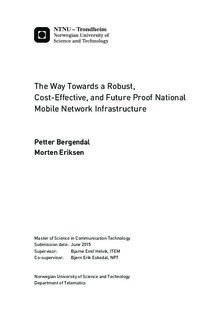| dc.description.abstract | The increased use of mobile devices and the introduction of smartphones
have changed the way people communicate. Over the last decade,
mobile networks have become a critical infrastructure. Private individuals,
governments and businesses rely on mobile networks to provide stable
and robust services, both in everyday life and in crisis. There is also
an increasing demand for capacity as new and more mobile broadband
challenging services are being used. The society will rely on the mobile
networks to provide higher capacity, more coverage and increased robustness
in the future to come. This provides new challenges for all actors
in the mobile industry, in order to meet the increasing demands of the
society.
The thesis is written in collaboration with the Norwegian Communication
Authority (Nkom) in order to investigate the future development of
the mobile network infrastructure with a techno-economical and regulatory
point of view. Through literature studies, the thesis has investigated
the offered capacity, coverage, and robustness of mobile networks today,
as well as the current market structure and current market shares in the
Norwegian mobile market. The thesis has also defined and investigated
four different strategies for future development of the mobile network
infrastructure. Each strategy has been analyzed and evaluated based
on nine selected factors, including coverage, capacity, robustness, and
regulation. The strategies investigated are:
1. Continue current development
2. Tighter cooperation between Mobile Network Operators (MNOs)
3. Network Functions Virtualization (NFV)
4. A more active government
The thesis presents the results of the strategy analysis in a comparison
matrix. The matrix provides an overview of the advantages and
disadvantages of each strategy, based on the factors analyzed. In an
overall perspective, the thesis found that a tighter cooperation between
Mobile Network Operators seems to be the most beneficial strategy of
the strategies investigated. | |

